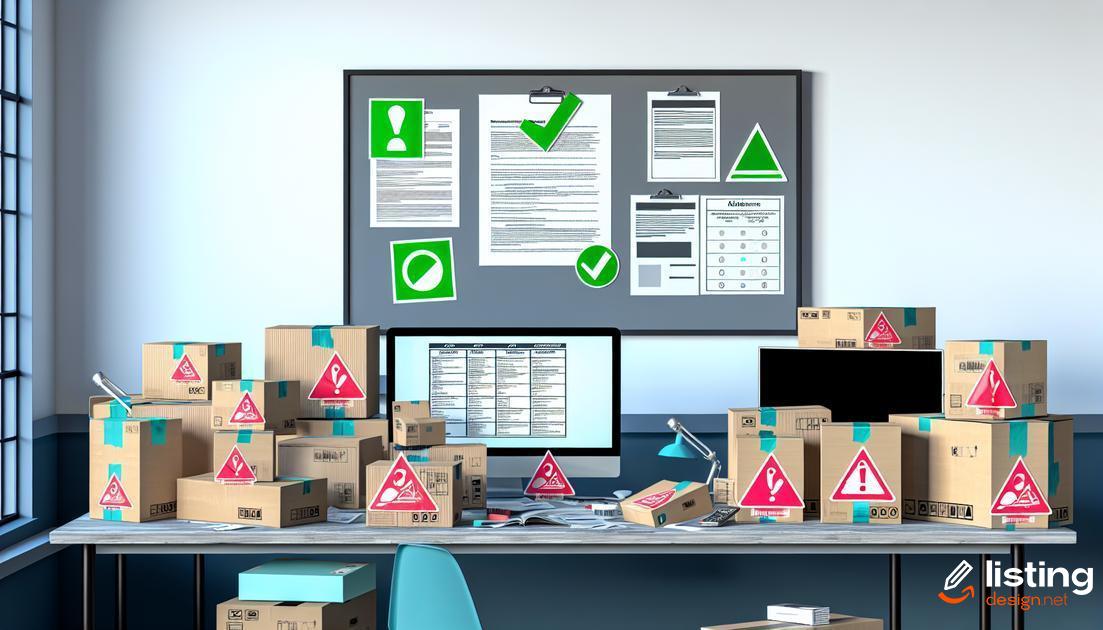Ensuring your products meet Amazon packaging compliance standards is crucial for success as a seller. These standards are in place to ensure that items are shipped safely and arrive in perfect condition, providing a great customer experience. In this blog post, we’ll break down the requirements and share essential tips to help you stay compliant.
Table of Contents
Understanding Amazon Packaging Requirements
To ensure Amazon Packaging Compliance, sellers must meet specific requirements set by Amazon. These requirements help reduce damages during transit and provide a positive customer experience. Key factors include using appropriate packaging materials and avoiding prohibited materials like certain plastics and non-recyclable items.
Products must be securely packaged to withstand the rigors of shipping. This means selecting materials that offer adequate protection based on the product’s size, weight, and fragility. Amazon specifies guidelines for sealed product packaging to prevent tampering and ensure safety.
Additionally, certain products must comply with frustration-free packaging standards, promoting easy-to-open, eco-friendly designs. Ensuring compliance involves regular checks and audits of packaging methods. Sellers must also stay updated with changes in Amazon’s packaging policies to avoid non-compliance issues.
The Importance of Packaging Compliance
Compliance with Amazon’s packaging standards is not only a regulatory requirement but a crucial aspect of maintaining customer satisfaction and reducing returns. Failing to adhere to these standards can lead to various negative outcomes, including customer dissatisfaction, increased return rates, and potential removal of your selling privileges on Amazon.
Amazon has specific packaging laws designed to ensure that products reach customers in perfect condition. These rules also help reduce waste and environmental impact. By following Amazon’s packaging requirements, you also contribute to the overall sustainability goals of the company.
Proper packaging compliance involves using appropriate materials that offer adequate protection during transit. Packaging must also adhere to size and weight restrictions to qualify for programs like Amazon’s Frustration-Free Packaging.
Failure to meet these standards can result in penalties or charges. Therefore, investing time and resources in compliant packaging is essential. Not only does it improve customer retention, but it also ensures smooth operations within the Amazon marketplace.
Packaging Materials: What You Can and Can’t Use
Using the right packaging materials is crucial for Amazon packaging compliance. First, understand that Amazon has specific guidelines on what you can and can’t use for packaging materials. The goal is to ensure the safety and stability of the product during shipping.
Acceptable packaging materials include corrugated boxes, paperboard, stretch wrap, and air pillows. These materials are durable and provide ample protection.
Corrugated boxes
are especially recommended due to their strength and ability to absorb impact.
However, there are materials you cannot use for Amazon packaging. This includes, but is not limited to, materials such as packing peanuts, crinkle paper, and shredded paper. These items can cause damage to the product or create a messy unboxing experience.
For liquid products, ensure the use of a double-sealed plastic bag and proper cushioning material. Electronics should be packed in anti-static bubble wrap to prevent any damage from static electricity.
Always adhere to the specific dimension requirements and avoid over-packaging or under-packaging to minimize the risk of product damage during transit. This not only ensures customer satisfaction but also mitigates the risk of returns or negative reviews.
Steps to Ensure Your Packaging is Compliant
- Review the Amazon packaging guidelines thoroughly. Ensure you understand the requirements specific to your product category.
- Choose appropriate packaging materials. Avoid materials that Amazon restricts, such as certain plastics and non-recyclable components.
- Test your packaging rigorously. This includes drop tests, compression tests, and thermal tests to simulate shipping conditions.
- Label your packages correctly. Ensure all labels, including barcodes and shipping labels, are properly placed and scannable.
- Use necessary protective packaging. Items must be secure, and void fillers should be used to prevent movement inside the box.
- Document your compliance. Keep records of your packaging choices, testing results, and compliance checks for Amazon audits.
- Stay updated with Amazon’s guidelines. Regulations and requirements can change, so regularly review their packaging standards.
Common Packaging Mistakes to Avoid
Skipping Label Requirements
Not adhering to Amazon’s label guidelines can cause major delays. Make sure barcodes are visible and scannable.
Using Non-Compliant Packaging Materials
Inappropriate materials can result in damage or rejection. Avoid prohibited plastic and ensure materials are approved.
Failing to Protect Fragile Items
Improper cushioning leads to breakage. Use bubble wrap or air pillows for delicate products.
Ignoring Weight Limits
Overweight packages can incur fines. Check Amazon’s weight limits before shipping.
Overlooking Preparation Instructions
Each category has specific prep requirements. Comply to avoid non-compliance issues.
Poor Package Sealing
Unsealed packages can lead to spills or loss. Use proper tape and sealing techniques.
Inconsistent Packaging Dimensions
Odd-sized packages are harder to handle. Stick to standard dimensions to ease processing.
Benefits of Proper Packaging Compliance
Complying with Amazon’s packaging requirements ensures that your products are safe throughout the shipping process. Proper packaging compliance reduces damage during transit, which leads to fewer customer complaints and returns. This helps maintain a high seller rating and customer satisfaction. Additionally, compliant packaging can enhance the unboxing experience for customers, reflecting positively on your brand.
Adhering to packaging standards can also minimize environmental impact, as it often involves using eco-friendly materials and reducing excess packaging. This can appeal to environmentally conscious consumers, potentially increasing brand loyalty. Moreover, proper packaging compliance avoids penalties from Amazon, such as fines or suspension, ensuring seamless operations and continued sales on the platform.
Amazon’s Frustration-Free Packaging Program
Amazon’s Frustration-Free Packaging Program aims to enhance the customer experience by reducing unnecessary packaging. Under this program, products are designed to be opened without the need for additional boxes, making them easy to open and recycle. The main goals are to minimize waste and improve sustainability practices.
The program is also geared towards protecting products throughout the shipping process. By using durable and eco-friendly materials, Amazon ensures that products arrive in perfect condition. This includes the elimination of plastic bindings, wire ties, and other forms of wasteful packaging materials.
Participating in the Frustration-Free Packaging Program can significantly impact customer satisfaction. When customers receive products that are easy to unpack and free from excessive packaging, it enhances their unboxing experience. This leads to positive reviews and potentially higher sales.
Manufacturers and sellers must meet specific criteria to join the program. These guidelines include package strength, ease of opening, recyclability, and the use of fewer materials. Meeting these requirements not only helps in adhering to Amazon’s standards but also aligns with broader environmental goals.
How to Handle Packaging Non-Compliance Issues
Addressing packaging non-compliance issues requires prompt action and thorough understanding. First and foremost, identify the specific non-compliance issue. Amazon typically provides a report detailing the problems. Carefully review this report to understand what went wrong.
Next, you should
correct the issue immediately
. This might mean adjusting the size or material of your packaging, making sure it meets Amazon’s guidelines. Work closely with your packaging supplier to make the necessary changes swiftly.
Once rectified, perform a quality check to ensure all new packages follow the corrected standards. Implementing a
quality assurance process
is crucial to avoid future issues. A small error can lead to larger problems if not addressed promptly.
Additionally, you’ll need to communicate with Amazon. Provide them with evidence of your corrective actions. This often involves submitting pictures or even the actual packaging for review. Transparency is key; keeping Amazon informed will help resolve the issue faster.
Remember, maintaining compliance is an ongoing process. Conduct regular reviews and stay updated on Amazon’s packaging requirements. Keeping a detailed log of changes made and periodic checks can help in maintaining compliance.
Lastly, consider
implementing training programs
for staff involved in packaging processes. Ensuring your team understands the importance of compliance and knows how to execute the standards can prevent future issues and ensure smooth operations.






